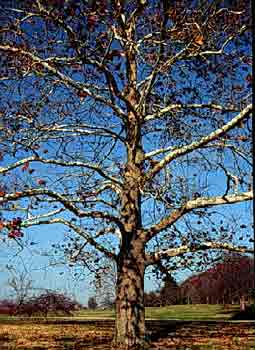 American Sycamore - Platanus occidentalis
American Sycamore - Platanus occidentalis
Sycamore Family (Platanaceae)
- Native habitat: Eastern U.S. in deciduous woods. Most abundant along streams and bottomlands.
- Growth habit: This large tree has a rounded, open, wide-spreading form and massive branches.
- Tree size: Known as a medium- to fast-growing tree, the London planetree can attain a height of 70 to 100 feet with a crown spreading to 65 to 80 feet.
 Flower and fruit: The small flowers are not showy but the bristly, rounded fruit are borne along a pendulous stalk. The 1-inch spiky brown balls persist into winter.
Flower and fruit: The small flowers are not showy but the bristly, rounded fruit are borne along a pendulous stalk. The 1-inch spiky brown balls persist into winter.- Leaf: The planetree's large leaves are maple-like although there is considerable variation in leaf shape and size. Fall color is not showy.
- Hardiness: Winter hardy to USDA Zone 5 (possibly 4).
The natural hybrid between American and Oriental sycamores (London planetree Platanus occidentalis x P. orientalis) has proven to be more disease resistant and commonly planted as a street, especially in Europe. It was first noted growing in London in the early 17th century. Because of its tolerance to soot and air pollution, it became the dominant ornamental tree in industrial London. Its tolerance of urban stresses quickly made it a popular.
 ‘Bloodgood' - Considered a superior cultivar. Adapts well to difficult sites and is resistant to anthracnose blight.
‘Bloodgood' - Considered a superior cultivar. Adapts well to difficult sites and is resistant to anthracnose blight.- ‘Columbia' - Pyramidal form, deeply lobed leaves; resistant to anthracnose and powdery mildew.
- ‘Liberty' - Has a five-lobed leaf that resembles a large maple leaf. It is resistant to anthracnose and powdery mildew. Tree trunks exfoliate early in irregular sheets, exposing the light green under-bark.
- ‘Sutternii' - An unusual cultivar with white exfoliating bark and variegated leaves.
 Additional information:
Additional information:The plane or sycamore family's genus name, Platanus, is derived from the Greek name for the Oriental planetree (P. orientalis), platanos. The peeling bark is an outstanding winter characteristic. The bark of American sycamore is usually whiter than the greenish bark of the London planetree. A serious problem with all species of Platanus is anthracnose. Infection causes defoliation, then the shoot tips die, leaving many small twigs at the ends of the branches. It is best to select cultivars of London planetree that are resistant to anthracnose. The round fruit of London planetree is an aggregate of achenes (nut-like fruits). They tend to be borne singly on our native sycamore (P. occidentalis) and in multiples of two or three on the hybrid London planetree. Plants in this genus have some interesting anatomical features. A large leaf-like stipule can be seen along the petiole (leafstalk) under the leaf blade. The petiole is also interesting. It completely encloses the buds along the branch. You have to break away the leaf to see the buds.


